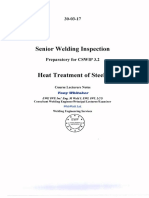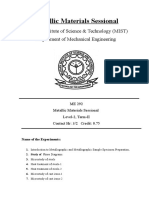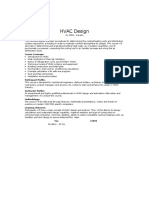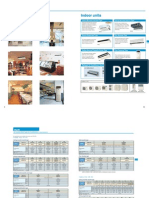Materials Science C14: Polymer Processing: Natural Sciences Tripos Part II
Materials Science C14: Polymer Processing: Natural Sciences Tripos Part II
Uploaded by
jameswood20Copyright:
Available Formats
Materials Science C14: Polymer Processing: Natural Sciences Tripos Part II
Materials Science C14: Polymer Processing: Natural Sciences Tripos Part II
Uploaded by
jameswood20Original Description:
Original Title
Copyright
Available Formats
Share this document
Did you find this document useful?
Is this content inappropriate?
Copyright:
Available Formats
Materials Science C14: Polymer Processing: Natural Sciences Tripos Part II
Materials Science C14: Polymer Processing: Natural Sciences Tripos Part II
Uploaded by
jameswood20Copyright:
Available Formats
Natural Sciences Tripos Part II
MATERIALS SCIENCE
C14: Polymer Processing
Dr J A Elliott
Easter Term 2011-12
II
Name......................... College............................
1
C14 - POLYMER PROCESSING
COURSE CONTENT
(6 lectures + 1 Examples Class)
A. Introduction
Motivation, Basic classification of polymers, basic types of processing
B. Basics of polymer melt rheology
Viscosity, Reynolds number, non-Newtonian behaviour, flow through a pipe, flow curves,
slippage, Bagley correction.
C. Materials Behaviour during the Processing Stages
Overview
Melt flow: die entry (extension, melt fracture), viscoelastic effects (Deborah number), ie- exit
effects (die swell, sharkskin), flow front (fountain flow, weld lines), orientation retraction)
Melting: memory effects, degradation, conductivity
Cooling: heat transfer, Fourier equation, shrinkage, crystallization
Mixing: additives, types of mixing, forces and energy
D. Industrial Processing Methods
Mixing: blending, intensive mixing
Extrusion based processes: screw extruders, blow moulding, bubble blowing, calendering,
Stentor process
Moulding processes: compression moulding, injection moulding, machine, rotational
moulding, reaction injection moulding, push-pull moulding
Thermoforming: vacuum, pressure
E. Processing Design
General principles, gating, mould filling design
2
Book List
1) W.A. Holmes-Walker: "Materials Processing [Unit 11]: Polymer Processing", Open
University 1981 (ABS6.7).
2) N.G. McCrum, CP. Buckley and CB. Bucknall, "Principles of Polymer Engineering",OUP,
1997 (AN6d.57a).
3) N.J. Mills, "Plastics", second edition, Edward Arnold, London 1993 (AN6c.126b).
4) J.A. Brydson: "Flow Properties of Polymer Melts", Butterworth, London, 1970 (AN6d.10).
5) D.H. Morton-Jones: "Polymer Processing", London, Chapman and Hall, 1989 (AN6d.56).
6) P. C. Powell and A.J. Ingen Housz: "Engineering with Polymers", 2
nd
ed. Stanley Thomas,
1998 (AN6d.29a).
3
A. Introduction
1. Motivation
Polymer products are part of our everyday life as well as some of the most advanced applications.
Polymer Processing is about the efficient control of their manufacturing, the harnessing of the
intrinsic polymer properties to achieve the desired end product properties, and the design of
machinery suitable for handling them. Its ongoing importance stems from the need to control
existing processes, to make new shapes, use different materials, reduce wastage and energy costs,
make lighter products, improve properties, lower the price.
The main concern of this course is the behaviour of polymers during processing, and to a small
extent the engineering design of processing equipment.
2. Basic classification of polymers with respect to processing
Thermoplastics Thermosets
Examples:
Washing-up bowl Tyres
Characteristics
4
2. Basic types of processing
- Shaping and moulding: Extrusion and injection moulding processes.
- Diagram of a screw extruder:
Diagram of an injection moulding set-up
Individual techniques are variations on the common theme and will be subject of a later section.
5
B. Basic polymer melt rheology
1. Viscosity
- Recap: measure of fluidity, thickness, consistency
- Definition: stress/ strain rate
- e.g. simple shear:
- cf. modulus = stress/strain
- Viscosity of polymers: high in comparison with most other liquids:
Range of viscosities in fluids:
Water
- Zn(450 C)
Polymer:
- High has some important effects
- Reasons: Long chain, entanglements.
6
The molecular weight has a strong effect on viscosity
Effect of shear strain on shear stress - non-Newtonian behaviour:
7
The definition of true viscosity ( ) and apparent viscosity ( ) in a pseudo plastic fluid.
- Shear thinning - what is the underlying molecular behaviour?
8
- Extensional flow: occurs in many processing situations
- Effects of extensional flow:
9
2. Flow through a circular pipe
2.1 Shear stress
10
2.2 Throughput and shear rate
11
12
2.3 Flow curves
On the basis of equations (1) and (6) it is possible to determine both the shear stress and the shear
rate at the wall for different outputs and pressures. This yields material specific curves, known as 'flow
curves' .
Different types of flow curves are:
q t q t vs , vs , vs
a a
.
However, it is cumbersome to determine flow curves. Therefore the apparent shear rate at the wall
is often replaced by
,
4
3
R
Q
a w,
t
= (11)
the so-called apparent shear rate at the wall. The justification for this is that it can be shown (see
Ref 4, section 2.2.3) that for a time-independent liquid, the shear stress is a function of 4Q/R
3
only,
and that the difference to the true case is less than 15%, which in general is acceptable.
The viscosity determined by
a w,
w
f a,
= q
(12)
is called the false apparent viscosity.
13
2.4 Power law fluids
Can we find an analytical expression describing the flow curve?
- Flow profiles:
Note tendency towards plug-flow for shear-thinning liquids.
14
2.5 Slippage
Equation (2) contains the velocity at the wall, previously set to zero. If we assume Poiseulle flow
(equation (5)), and replace the pressure drop by the wall stress (equation (1)), we get:
-> lubrication approximation:.
15
2.6 The Bagley correction
Streamlines indicating the flow pattern at the entry point to a tube. Note the significant axial
acceleration before the start of the tube.
This leads to some pre-tube pressure drop, shown in the following Figure.
16
Bagley (1957) introduced a correction for P
entry
, treated as increasing the effective tube length:
A typical Bagley plot is shown in the Figure below.
17
C. Polymer behaviour during the processing stages
1. Overview of processing stages and their main features
Mixing
Melting
Meltflow
Cooling and solidification
Crosslinking
18
2. Melt flow
2.1 Introduction
Many polymer processing methods involve a polymer melt being driven through channels of
various dimensions (extrusion dies, injection moulding runners, gates, and moulds). Here we study
some basic aspects of such processes.
2.2 Effects of viscoelasticity
Recap: Maxwell element.
A measure of the extent to which elastic processes can be expected is given by the Deborah Number:
Example of process memory:
19
- Die swell: As the polymer leaves the die, the extrudate diameter increases. This is also a
viscoelastic effect, largely due to the highly shear-oriented polymer molecules close to the wall.
20
21
2.3 Die entry effects
Convergent flow at the die entry leads to extensional flow.
If the resulting tensile stress exceeds the tensile strength of the melt (ca 10
6
Nm
-2
), the result is so-
called melt fracture, leading to poor products:
22
2.4 Die-exit effects
As the melt leaves the tube (die), the material close to the wall has to accelerate. This generates a
tensile stress which leads to surface orientations. If the stress exceeds the melt strength surface
ruptures appear, described as sharkskin: . If the conditions become worse, one gets 'orange peel', and
eventually 'bambooing'.
23
2.5 The flow front
Fountain flow:
Weld lines: form where two melt fronts meet and join together.
Effects: Weakness, surface blemishes, crack-like defects
24
3. Melting
4. Cooling
4.1 Heat flow
- Consider polymer surface in contact with cold surface (of metal, water or air), such that heat
transfer away from the surface is fast. Rate limiting process then is the internal heat transfer by
conduction within the polymer. This is quantified by the Biot number Bi = hL/k , where h is the
surface heat transfer coefficient. Typically, h =1000 Wm
-2
K
-1
, L =1mm, hence Bi 1. This
means that the temperature difference at the surface T- T
e
is small compared to the through
thickness variation.
Consider a polymer product as a series of flat elements:
25
The flow of heat can be described by a 1-dim heat conduction equation:
More simply, assuming k to be temperature independent, we get the important parameter a, known
as thermal diffusivity:
Since Bil, we can also approximate T at surface = T
e
. Then the main term in the solution of the pde
yields:
( ) 4 exp
2
/ Fo T T
e ave
t
2
t/L Fo o = with .
Hence cooling is exponential, and the time taken to reach a certain degree of cooling is L
2
/ a.
With a typically 10
-7
m
2
s
-1
, and L = 1mm, times are 10-100 sec. Want to keep wall thickness as
small as possible to reduce cooling time!
4.2 Effects of freezing
Solidification starting from the quenched wall: Neumann-Stefan Problem
26
Progress of crystallization into semi-infinite space
Inhomogeneities in structure: skin-core texture, transcrystallization:
27
- Frozen-in orientation Reheating of product allows relaxation of stretched molecules: retraction..
This leads to shrinkage in parts of the product, warping etc. But put to use in shrink-wrapping.
- Effects of core freezing last: Shown in Figure 31 is the internal stress distribution across the
thickness of a sheet of polycarbonate. The surface regions are in compression, the centre is in
tension. Fig 32: Residual stresses, sink marks and voids.
28
3. Mixing
3.1 Purposes of mixing
3.2 Types of mixing
Different processes/additives/polymers require different types of mixing. In principle, distinguish
two types:
(a) distributive mixing (extensive mixing, blending)
(b) dispersive mixing (intensive mixing, compounding)
They are conflicting processes:
3.3 Forces in mixing
Forces are transmitted by fluid mechanical stress in the mixer! Calculate the energy per unit volume
necessary to exert a certain stress. We have
Hence less energy is needed under high viscosity conditions to achieve good dispersion. 'Baker
prefers kneading a stiff dough to beating a thin batter'.
29
3.4 Types of additives
Affecting physical properties:
Plasticizers
- Active fillers: reinforcing, toughening, improved abrasion resistance, conductivity,
- Short fibres:
- Rubber:
- Polymer: (blends)
- Pigments:
- modified clay (nanocomposite):
- inert fillers:
Affecting chemical properties:
- Cross linking agents -
- Foaming Agents -
- Protective additives:
- Antistatic agents -
- UV absorbers:
- Flame retardants:
Affecting processing properties:
Lubricants
30
D. Industrial Processing Methods
1. Mixing
31
2. Extrusion
2.1 Screw Extruder
32
33
34
35
36
37
38
39
40
41
42
43
Examples Class
1. Define what is meant by a power law fluid and indicate the form of its flow curve. The figure
below shows flow curves for polypropylene (melting point about 165 C).
Show how the behaviour at 180 C can be described in terms of two power law fluids.
Determine the corresponding exponents. Convince yourself that the curve could be well
described by the Ellis model which is expressed as:
1
0
+ =
q
q a
k
Account for the different behaviour shown at 170 C, and hence suggest why the flow curve
at 180 C can be fitted to power law functions rather more successfully than would generally
be the case.
2. The material for which the flow curve is given in the handout on page 12 is to be extruded
through a slit die at 210 C, and hauled off without tension at a speed of 1 cm s
1
. The
dimensions of the die are length L = 200 mm, width w = 20 mm, and height h = 2 mm.
Assuming w h, derive the expression for the shear stress as a function of position in the die,
and the apparent strain rate. (Follow the methodology used in lectures for the cylindrical pipe
geometry). Calculate the maximum apparent shear rate in the die. Use the flow curve to
estimate the pressure drop in the die, assuming that the apparent viscosities given are actually
false apparent viscosities. As a comparison, discuss the cases of a power law fluid and a
Newtonian fluid.
44
3. Why is the die swell across the width of a sheet less than across the thickness?
You want to extrude bars with the cross sections shown below from a polymeric material.
Roughly what shapes would the respective dies have to be?
4. Each half of a standard audio tape cassette has the form sketched below. Consider production
from polystyrene by injection molding through a gate as indicated. Using a melt temperature
of 180 C and a mould temperature of 20 C, many mouldings are found to have cracks.
Where would the crack most likely appear? As a remedy you consider increasing the melt
temperature to 230 C, or increasing the mould temperature to 40 C. Why are these steps
likely to help? Also suggest and explain a more radical solution.
45
Question Sheet
1. Explain, by using a processing equation, two ways by which your body may control blood
pressure. Which is likely to be more efficient and why?
2. The flow behaviour of polypropylene was investigated on a capillary rheometer. A die of
length L = 14 mm, and diameter D = 2 mm were used. The polymer was forced through the
die from a barrel reservoir of diameter d = 10 mm by a moving piston. The pressures required
to achieve certain piston velocities were recorded on a chart writer, which was calibrated as
giving 1.192 MPa mm
1
. From the measurements shown below, determine the shear stresses,
apparent shear rates at the wall and false apparent viscosities, and draw the viscosity-stress
flow curve. Can you estimate the difference between the apparent and the actual
(Rabinowitsch) wall shear rate?
V [mm/sec] P [mm]
0.333 12.7
0.625 15.9
0.833 17.9
1.667 23.2
2.50 27.2
3. As explained in the lectures, melt fracture may be caused by an excessive stress exerted on the
polymer melt in the die entry region. Discuss the factors involved in causing this stress and
suggest possible remedies. Which is likely to be the most effective?
4. Injection moulded articles generally show an oriented microstructure. (a) Describe an
advantageous and a disadvantageous effect of the orientation. (b) Which two ways may be
used to reduce the degree of orientation, and why?
5. What is the processing method of choice for (i) the cylinder of a bicycle pump, (ii) the
handle?
6. Give some differences between polymer melt processing and metal casting and discuss their
implications for processing and product properties.
You might also like
- MetallurgyDocument17 pagesMetallurgyirajfarji2481No ratings yet
- Extrusion and Its ApplicationDocument28 pagesExtrusion and Its ApplicationLakhan GuptaNo ratings yet
- Non-Traditional Machining: Electro Chemical Machining (ECM)Document14 pagesNon-Traditional Machining: Electro Chemical Machining (ECM)NimoNo ratings yet
- Chapter2 - AJMDocument13 pagesChapter2 - AJMravish kumarNo ratings yet
- Cold Form Steel PDFDocument70 pagesCold Form Steel PDFJohnnatan ViniciusNo ratings yet
- 01 - Fundamentals of Metalworking-2017son01Document92 pages01 - Fundamentals of Metalworking-2017son01emreNo ratings yet
- Electron Beam MachiningDocument25 pagesElectron Beam MachiningAbhay P John100% (2)
- Chapter 7 Dislocations and Strengthening MechanismsDocument5 pagesChapter 7 Dislocations and Strengthening Mechanismsapril heramizNo ratings yet
- Metallurgical Insights 3Document3 pagesMetallurgical Insights 3Charlie BondNo ratings yet
- Lecture 7-8 PPT Slides - Materials StrengtheningDocument47 pagesLecture 7-8 PPT Slides - Materials StrengtheninghenryNo ratings yet
- Lec5-Yield Phenomenon, Strain Aging, & Bauchinger EffectDocument14 pagesLec5-Yield Phenomenon, Strain Aging, & Bauchinger Effectsamurai7_77No ratings yet
- Wear and Wear Mechanisms PDFDocument29 pagesWear and Wear Mechanisms PDFmstfdrmzNo ratings yet
- Welding and Types of WeldingDocument9 pagesWelding and Types of WeldingMunem ShahriarNo ratings yet
- Corrosion Resistance of High Nitrogen Steels PDFDocument27 pagesCorrosion Resistance of High Nitrogen Steels PDFAnil Kumar TNo ratings yet
- ME8352-Manufacturing Technology - I (MT-I) With QBDocument91 pagesME8352-Manufacturing Technology - I (MT-I) With QBMohana KrishnanNo ratings yet
- 11 StrainHardeningDocument43 pages11 StrainHardeningRahman PratamaNo ratings yet
- Metal Joining Processes: Prof. Mayur S Modi Assistant Professor Mechanical Engineering Department Ssasit, SuratDocument79 pagesMetal Joining Processes: Prof. Mayur S Modi Assistant Professor Mechanical Engineering Department Ssasit, SuratPrateekNo ratings yet
- Plastic Deformation of MetalsDocument42 pagesPlastic Deformation of MetalsNaresh DeshpandeNo ratings yet
- SuperplasticityDocument11 pagesSuperplasticityAbhishek Goel100% (2)
- Experimental Investigation On TIG Welded Aluminium Alloy 6082 Weldment Using Non Destructive EvaluationDocument4 pagesExperimental Investigation On TIG Welded Aluminium Alloy 6082 Weldment Using Non Destructive EvaluationEditor IJTSRDNo ratings yet
- Strain Hardening PDFDocument2 pagesStrain Hardening PDFebsanNo ratings yet
- Sir Alan Cottrell and The Dislocation Mechanics of FracturingDocument11 pagesSir Alan Cottrell and The Dislocation Mechanics of FracturingSaurabh ShashankNo ratings yet
- Development of Austenitic Stainless Steel Sheets For Micro-FabricationDocument7 pagesDevelopment of Austenitic Stainless Steel Sheets For Micro-FabricationWasawat JoongjaiNo ratings yet
- Metallurgy Lecture NotesDocument103 pagesMetallurgy Lecture Notesفرح تامرNo ratings yet
- Copper and The Copper-Base AlloysDocument32 pagesCopper and The Copper-Base AlloysVIVEK UPADHYAYNo ratings yet
- Heat Treatment of SteelDocument11 pagesHeat Treatment of SteelMohamed El-gammalNo ratings yet
- Retained Austenite and PittingDocument6 pagesRetained Austenite and PittingSuhaib AshrafNo ratings yet
- Strengthening MechanismsDocument21 pagesStrengthening MechanismsBren SisonNo ratings yet
- 2019-High Cycle Fatigue Behavior of Hard Turned 300 M Ultra-High Strength SteelDocument12 pages2019-High Cycle Fatigue Behavior of Hard Turned 300 M Ultra-High Strength SteelYoussef Mbarek100% (1)
- Question Sheet 2, Solidification: Question Sheet 2 Materials Science Part Ib AQ2 COURSE A: Phase TransformationsDocument3 pagesQuestion Sheet 2, Solidification: Question Sheet 2 Materials Science Part Ib AQ2 COURSE A: Phase Transformationsalisamer60No ratings yet
- 2014 11 NiResistDocument12 pages2014 11 NiResistfelipeNo ratings yet
- Manufacturing Processes (ME361) Lecture 25 and 27Document40 pagesManufacturing Processes (ME361) Lecture 25 and 27RandhirKumarNo ratings yet
- 3.stress ReliefDocument2 pages3.stress ReliefRajeevSangamNo ratings yet
- lectut-MTN-513-pdf-Structure of Crystalline CeramicsDocument53 pageslectut-MTN-513-pdf-Structure of Crystalline CeramicsAkash AgarwalNo ratings yet
- Composition of Steels PDFDocument5 pagesComposition of Steels PDFNitin SharmaNo ratings yet
- 0-Mechanical Behaviour of Materials (Volume 2-Viscoplasticity, Damage, Fracture and Contact Mechanics) (Dominique François, André Pineau & André Zaou) PDFDocument413 pages0-Mechanical Behaviour of Materials (Volume 2-Viscoplasticity, Damage, Fracture and Contact Mechanics) (Dominique François, André Pineau & André Zaou) PDFAndres Perez CruzNo ratings yet
- Shape Memory AlloyDocument22 pagesShape Memory AlloyCSETUBENo ratings yet
- Dislocations and Plastic DeformationDocument6 pagesDislocations and Plastic DeformationPrashanth VantimittaNo ratings yet
- Mechanical and Microstructure Properties of 304 Stainless Steel Friction Welded JointDocument10 pagesMechanical and Microstructure Properties of 304 Stainless Steel Friction Welded JointSUBHASHIS SAHOONo ratings yet
- 2-Mechanisms of StrengtheningDocument18 pages2-Mechanisms of StrengtheningRalph Victor MalimetNo ratings yet
- Heat TreatmentDocument24 pagesHeat TreatmentOlanrewaju Slyman Damilola100% (1)
- ME 292 - Metallic Materials SessionalDocument39 pagesME 292 - Metallic Materials SessionalMuhammedNayeemNo ratings yet
- Emat Fa1.4 - q1.4 Long QuizDocument6 pagesEmat Fa1.4 - q1.4 Long QuizUC MARE MARITIME SYLLABUS CDRCNo ratings yet
- Metal Oxides Semiconductor CeramicsDocument14 pagesMetal Oxides Semiconductor Ceramicsumarasad1100% (1)
- 2007 Russian Aluminum Alloys For Ultra Deep Water EngDocument8 pages2007 Russian Aluminum Alloys For Ultra Deep Water EngHossam Ali RaghebNo ratings yet
- Shear and Bending Moment Diagrams - A ReviewDocument15 pagesShear and Bending Moment Diagrams - A ReviewNicole Ann PedriñaNo ratings yet
- Phase DiagramsDocument23 pagesPhase DiagramsnvemanNo ratings yet
- Me6302 - Manufacturing Technology - I: Iii Semester Mechanical EngineeringDocument69 pagesMe6302 - Manufacturing Technology - I: Iii Semester Mechanical EngineeringamdevaNo ratings yet
- 06 Strengthening MechanismsDocument63 pages06 Strengthening Mechanismspranavkumarparit100% (2)
- MT 03 - Mechanical Properties and Tests, A-Z Abbrev (Tinius Olsen - Kul 1)Document25 pagesMT 03 - Mechanical Properties and Tests, A-Z Abbrev (Tinius Olsen - Kul 1)zingerNo ratings yet
- Exp 4Document11 pagesExp 4masuma lovelyNo ratings yet
- Cold MoldingDocument5 pagesCold MoldingMoiz AmirNo ratings yet
- CoorosionDocument61 pagesCoorosionniginpNo ratings yet
- Multiplate Clutch Diaphragm TypeDocument23 pagesMultiplate Clutch Diaphragm TypeSwastikBhattacharyaNo ratings yet
- Issues To Address... : Chapter 5-1Document58 pagesIssues To Address... : Chapter 5-1Nasser SANo ratings yet
- Chapter 2Document59 pagesChapter 2Temesgen Zeleke100% (1)
- The Working of Steel: Annealing, Heat Treating and Hardening of Carbon and Alloy SteelFrom EverandThe Working of Steel: Annealing, Heat Treating and Hardening of Carbon and Alloy SteelNo ratings yet
- Vgi Lithium Polymer Msds v3Document13 pagesVgi Lithium Polymer Msds v3jameswood20No ratings yet
- AxialDocument436 pagesAxialjameswood20100% (3)
- Singlemode LGX Coupler Module: FeaturesDocument1 pageSinglemode LGX Coupler Module: Featuresjameswood20No ratings yet
- David E. Roberts: Industry Night PresentsDocument5 pagesDavid E. Roberts: Industry Night Presentsjameswood20No ratings yet
- Filar, Refrigeration 1Document9 pagesFilar, Refrigeration 1Rahwan Qadir SlemanNo ratings yet
- U4 - Vapour Power Cycles - 20201006 - SDocument17 pagesU4 - Vapour Power Cycles - 20201006 - SGurunath AeroNo ratings yet
- Aire Acondicionado LGDocument78 pagesAire Acondicionado LGAnonymous ec2P0F5iKXNo ratings yet
- Analysis of The Building Envelope Influence To Building Energy Consumption in The Cold RegionsDocument7 pagesAnalysis of The Building Envelope Influence To Building Energy Consumption in The Cold RegionsDavid YunganNo ratings yet
- The Initial Process in Coal Based Thermal Power Plant Is Coal Handling - The Function of Coal Handling Plant in Thermal Power Plant Is To ReceiveDocument5 pagesThe Initial Process in Coal Based Thermal Power Plant Is Coal Handling - The Function of Coal Handling Plant in Thermal Power Plant Is To ReceiveSubhadip MondalNo ratings yet
- Experiment 2 - Methods of MixturesDocument6 pagesExperiment 2 - Methods of MixturesAngelica UyNo ratings yet
- The East Gate CenterDocument4 pagesThe East Gate CenterHector Oliver100% (1)
- E6021 Compressor Engagement - Wiring Diagram - Lancia - Ypsilon - Elearn - 4cardataDocument2 pagesE6021 Compressor Engagement - Wiring Diagram - Lancia - Ypsilon - Elearn - 4cardataAnonymous TqVS8FdNo ratings yet
- Air Handling Unit Test DataDocument65 pagesAir Handling Unit Test DataNorman CanlasNo ratings yet
- Tacite UgDocument129 pagesTacite Ugarmando0212-1No ratings yet
- Res 1st Sem (1-5mod)Document95 pagesRes 1st Sem (1-5mod)riseke6817No ratings yet
- Wind TechnicquesDocument19 pagesWind TechnicquesCeciliaNo ratings yet
- 5 Sem SyllabusDocument7 pages5 Sem Syllabusadityakushwaha371No ratings yet
- Boundary Layer Equations - Non-Dimensional EquationsDocument8 pagesBoundary Layer Equations - Non-Dimensional Equationsmsnaghavi100% (1)
- Cypetherm SuiteDocument72 pagesCypetherm SuitevickersNo ratings yet
- TFS4.5FT Tropical Compressor R134a 115-127V 60Hz: CompressorsDocument2 pagesTFS4.5FT Tropical Compressor R134a 115-127V 60Hz: CompressorsMarcos GuardiaNo ratings yet
- Whirpool No Frost Refrigerator Parts and Service ManualDocument22 pagesWhirpool No Frost Refrigerator Parts and Service Manualcinefil70No ratings yet
- Company Profile 2014 CompleteDocument41 pagesCompany Profile 2014 Completerachman hardianNo ratings yet
- Hsu 12LF03Document58 pagesHsu 12LF03vrbanc1No ratings yet
- BoQ - Insulation Works (Group 1)Document5 pagesBoQ - Insulation Works (Group 1)Bhavanishankar ShettyNo ratings yet
- Document Hvac CourseDocument11 pagesDocument Hvac CoursemahmadwasiNo ratings yet
- Shell and Tube Heat Exchanger DesignDocument31 pagesShell and Tube Heat Exchanger DesigniB13eNo ratings yet
- Stock Summary Report: Company: DivisoinDocument44 pagesStock Summary Report: Company: DivisoinHungry ViperNo ratings yet
- Johnson-Controls-A19 - General-Data-SheetDocument2 pagesJohnson-Controls-A19 - General-Data-SheetMemoGENo ratings yet
- Air Conditioner Using Peltier ModuleDocument6 pagesAir Conditioner Using Peltier ModuleMuhammad AtifNo ratings yet
- Temperauture.: Prob. Solution: GivenDocument9 pagesTemperauture.: Prob. Solution: Givenharsh patelNo ratings yet
- EAT Ransfer: What Is Heat TransferDocument43 pagesEAT Ransfer: What Is Heat TransferSalwanNo ratings yet
- Design Simulation Construction of SwimmingDocument26 pagesDesign Simulation Construction of Swimmingmohamed algharbiNo ratings yet
- Ventilation FanDocument7 pagesVentilation FanadamzulkarnainNo ratings yet
- Daikin Casette 3 PK, SC-71K, FHYC71K (Indoor) + Outdoor)Document2 pagesDaikin Casette 3 PK, SC-71K, FHYC71K (Indoor) + Outdoor)Ware HandokoNo ratings yet





























































































